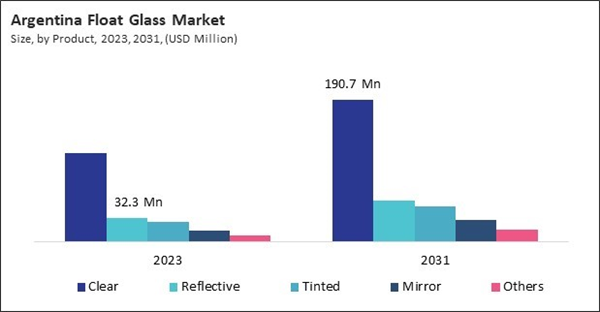The Latin America, Middle East and Africa Float Glass Market is projected to witness market growth of 6.1% CAGR during the forecast period (2024-2031).
The Brazil market dominated the LAMEA Float Glass Market by Country in 2023, and is forecast to continue being a dominant market till 2031; thereby, achieving a market value of $1.16 billion by 2031. The Argentina market is registering a CAGR of 6.9% during (2024 - 2031). Additionally, The UAE market would capture a CAGR of 5% during (2024 - 2031).
Float glass is highly valued in producing electronic screens due to its exceptionally smooth surface and excellent optical properties. These attributes are essential for creating the clear, sharp displays consumers expect in modern devices. The precision and quality control inherent in the float glass manufacturing process ensures that the glass used in screens is free from distortions and defects, which is crucial for maintaining the high visual standards required for electronic displays.
Despite numerous growth opportunities, the market faces challenges that could impact its development. One significant challenge is the high cost of production. In order to manufacture float glass, a significant capital investment is necessary in the form of advanced apparatus, raw materials, and energy consumption. Price fluctuations in basic materials, including silica sand, soda ash, and limestone, exacerbate cost volatility, rendering it difficult for manufacturers to effectively plan and budget.
Urbanization and infrastructure development initiatives in Africa, supported by government investments and international aid, drive the demand for float glass. According to the United Nations, Africa's urban population is expected to triple by 2050, reaching 58.9%. This rapid urbanization necessitates the development of new housing, commercial spaces, and public infrastructure, creating a substantial market for float glass. Moreover, international aid and investment are crucial in Africa's infrastructure development. The African Development Bank (AfDB) has committed billions of dollars to infrastructure projects, focusing on urban development, transportation, and energy. These investments support infrastructure modernization and adoption of energy-efficient technologies, further boosting the demand for float glass. Therefore, the region presents lucrative growth opportunities for the market.
The Brazil market dominated the LAMEA Float Glass Market by Country in 2023, and is forecast to continue being a dominant market till 2031; thereby, achieving a market value of $1.16 billion by 2031. The Argentina market is registering a CAGR of 6.9% during (2024 - 2031). Additionally, The UAE market would capture a CAGR of 5% during (2024 - 2031).
Float glass is highly valued in producing electronic screens due to its exceptionally smooth surface and excellent optical properties. These attributes are essential for creating the clear, sharp displays consumers expect in modern devices. The precision and quality control inherent in the float glass manufacturing process ensures that the glass used in screens is free from distortions and defects, which is crucial for maintaining the high visual standards required for electronic displays.
Despite numerous growth opportunities, the market faces challenges that could impact its development. One significant challenge is the high cost of production. In order to manufacture float glass, a significant capital investment is necessary in the form of advanced apparatus, raw materials, and energy consumption. Price fluctuations in basic materials, including silica sand, soda ash, and limestone, exacerbate cost volatility, rendering it difficult for manufacturers to effectively plan and budget.
Urbanization and infrastructure development initiatives in Africa, supported by government investments and international aid, drive the demand for float glass. According to the United Nations, Africa's urban population is expected to triple by 2050, reaching 58.9%. This rapid urbanization necessitates the development of new housing, commercial spaces, and public infrastructure, creating a substantial market for float glass. Moreover, international aid and investment are crucial in Africa's infrastructure development. The African Development Bank (AfDB) has committed billions of dollars to infrastructure projects, focusing on urban development, transportation, and energy. These investments support infrastructure modernization and adoption of energy-efficient technologies, further boosting the demand for float glass. Therefore, the region presents lucrative growth opportunities for the market.
List of Key Companies Profiled
- AGC Inc.
- Asahi India Glass Limited
- Cardinal Glass Industries, Inc.
- Central Glass Co., Ltd.
- Fuyao Glass Industry Group Co., Ltd.
- Guardian Industries Corporation (Koch Industries)
- Nippon Sheet Glass Co. Ltd.
- Saint-Gobain S.A.
- Taiwan Glass Ind. Corp.
- Xinyi Glass Holdings Limited
Market Report Segmentation
By End-use- Building & Construction
- Automotive & Transportation
- Energy
- Others
- Clear
- Reflective
- Tinted
- Mirror
- Others
- Brazil
- Argentina
- UAE
- Saudi Arabia
- South Africa
- Nigeria
- Rest of LAMEA
Table of Contents
Chapter 1. Market Scope & Methodology
Chapter 2. Market at a Glance
Chapter 3. Market Overview
Chapter 4. LAMEA Float Glass Market by End-use
Chapter 5. LAMEA Float Glass Market by Product
Chapter 6. LAMEA Float Glass Market by Country
Chapter 7. Company Profiles
Companies Mentioned
- AGC Inc.
- Asahi India Glass Limited
- Cardinal Glass Industries, Inc.
- Central Glass Co., Ltd.
- Fuyao Glass Industry Group Co., Ltd.
- Guardian Industries Corporation (Koch Industries)
- Nippon Sheet Glass Co. Ltd.
- Saint-Gobain S.A.
- Taiwan Glass Ind. Corp.
- Xinyi Glass Holdings Limited
Methodology

LOADING...









